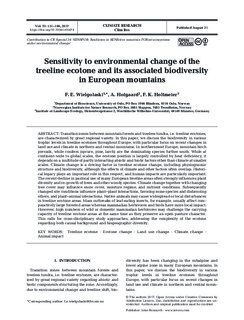| dc.contributor.author | Wielgolaski, Frans Emil | |
| dc.contributor.author | Hofgaard, Annika | |
| dc.contributor.author | Holtmeier, Friedrich-Karl | |
| dc.coverage.spatial | Europa, Europe | nb_NO |
| dc.date.accessioned | 2017-09-07T09:58:36Z | |
| dc.date.available | 2017-09-07T09:58:36Z | |
| dc.date.created | 2017-08-29T11:52:23Z | |
| dc.date.issued | 2017 | |
| dc.identifier.citation | Climate Research (CR). 2017, 73 151-166. | nb_NO |
| dc.identifier.issn | 0936-577X | |
| dc.identifier.uri | http://hdl.handle.net/11250/2453528 | |
| dc.description.abstract | Transition zones between mountain forests and treeless tundra, i.e. treeline ecotones, are characterized by great regional variety. In this paper, we discuss the biodiversity in various trophic levels in treeline ecotones throughout Europe, with particular focus on recent changes in land use and climate in northern and central mountains. In northernmost Europe, mountain birch prevails, while conifers (spruce, pine, larch) are the dominating species further south. While at continent-wide to global scales, the ecotone position is largely controlled by heat deficiency, it depends on a multitude of partly interacting abiotic and biotic factors other than climate at smaller scales. Climate change is a driving factor in treeline ecotone change, including physiognomic structure and biodiversity, although the effects of climate and other factors often overlap. Historical legacy plays an important role in this respect, and human impacts are particularly important. The recent decline in pastoral use of many European treeline areas often strongly influences plant diversity and re-growth of trees and other woody species. Climate change together with changing tree cover may influence snow cover, moisture regime, and nutrient conditions. Subsequently changed site conditions influence plant−plant interactions, favoring some species and disfavoring others, and plant−animal interactions. Native animals may cause widespread or local disturbances in treeline ecotone areas. Mass outbreaks of leaf-eating insects, for example, usually affect comparatively large forested areas whereas mammalian herbivores and birds have more local impact. However, high numbers of wild or domestic mammalian herbivores may challenge the carrying capacity of treeline ecotone areas at the same time as they preserve an open pasture character. This calls for cross-disciplinary study approaches, addressing the complexity of the ecotone regarding both causal background and biogeographic diversity. | nb_NO |
| dc.language.iso | eng | nb_NO |
| dc.rights | Navngivelse 4.0 Internasjonal | * |
| dc.rights.uri | http://creativecommons.org/licenses/by/4.0/deed.no | * |
| dc.subject | Treeline ecotone | nb_NO |
| dc.subject | ecotone change | nb_NO |
| dc.subject | land use change | nb_NO |
| dc.subject | climate change | nb_NO |
| dc.subject | animal impact | nb_NO |
| dc.title | Sensitivity to environmental change of the treeline ecotone and its associated biodiversity in European mountains | nb_NO |
| dc.type | Journal article | nb_NO |
| dc.type | Peer reviewed | nb_NO |
| dc.description.version | publishedVersion | nb_NO |
| dc.subject.nsi | VDP::Matematikk og Naturvitenskap: 400::Zoologiske og botaniske fag: 480 | nb_NO |
| dc.source.pagenumber | 151-166 | nb_NO |
| dc.source.volume | 73 | nb_NO |
| dc.source.journal | Climate Research (CR) | nb_NO |
| dc.identifier.doi | 10.3354/cr01474 | |
| dc.identifier.cristin | 1489425 | |
| dc.relation.project | Andre: German Research Foundation | nb_NO |
| dc.relation.project | Andre: Lapland Atmosphere-Biosphere Facility (LAPBIAT, EU) | nb_NO |
| dc.relation.project | Andre: COST (European Cooperation in Science and Technology) | nb_NO |
| dc.relation.project | Norges forskningsråd: 160022 | nb_NO |
| dc.relation.project | Andre: CLIMFOR project (grant code EEA-jrp-ro-no-2013-1-0204) | nb_NO |
| dc.relation.project | Norges forskningsråd: 244557 | nb_NO |
| cristin.unitcode | 7511,2,0,0 | |
| cristin.unitname | Avdeling for terrestrisk økologi | |
| cristin.ispublished | true | |
| cristin.fulltext | original | |
| cristin.qualitycode | 1 | |

